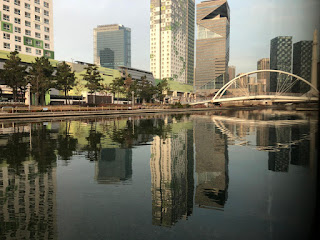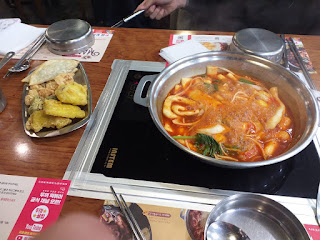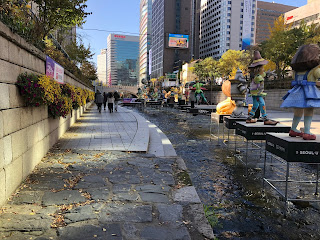Day 1
Upon landing in Korea, the airport appears rather normal, except that I am now thrust into a foreign land with most signages being in Korean.
Outside the restaurant where we had dinner lies a memorial to commemorate the turning point in the Korean war when U.S. troops came in to fight off the North Korean troops. There were shops along the entire street, and apart from this plaque, we might not have known the significance of the place.
We had a hot pot for dinner, cooking fresh seafood caught in Korea, it was a big contrast to what I usually eat in Singapore, and was interesting to eat the food I have never tried before.
Day 2
Upon arriving at the Incheon Academy for Science and Arts (IASA), we were warmly welcomed by the students and teachers of IASA. The ceremony took almost an hour, and they introduced us to what the school does and its special curriculum that is largely self-directed and research-based. We were treated to an amazing performance by some members of the IASA orchestra as well as their choir.
Being a high school, their lessons are more advanced than in Singapore. Nevertheless, the Earth Science (Geography) teacher at IASA tried his best to teach in English, much to the humour of the native students. They apply many new formulas that I had never seen before, and I gained a deeper understanding of the knowledge I already learned back in Singapore. Comparing to the time I spent in schools in China and Singapore, teaching styles in classrooms remain similar across cultures.
At night, we went to the observatory on the roof of IASA, where the astronomy students prepared telescopes to allow us to see stars and planets in the night sky. The skies in Korea are much clearer, allowing us to see celestial bodies much more clearly and see some that we would otherwise be unable to observe in Singapore.
At night, we went to the observatory on the roof of IASA, where the astronomy students prepared telescopes to allow us to see stars and planets in the night sky. The skies in Korea are much clearer, allowing us to see celestial bodies much more clearly and see some that we would otherwise be unable to observe in Singapore.
Reflection:
Publish: The hospitality and welcomeness of the people in IASA, especially during the welcoming ceremony this morning felt overwhelming. Throughout the day, I met a lot of different people and tried my best to fit in their culture, greeting the teachers and bowing to show appreciation throughout the day.
Process: Through the actions and behaviours of the people I met throughout the day, I can understand and appreciate the gracious culture instilled in all the Koreans. It made me feel guilty of not being just as hospitable and friendly to them when some of their students had come to Singapore earlier in the year. It was overwhelming to be treated so nicely, especially considering that they went out of their way, and spent money to ensure our experience in their school was fruitful. I found it awkward to be treated so well, with the students trying their best to use English to communicate with us, while I am basically unable to understand the Korean language. I could only keep a smile on my face and be thankful to everyone at the school.
Generalise: Through this experience, I have learnt the importance of being gracious and welcoming to people. Being thoughtful and improving small details can make other's experiences much more comfortable and enjoyable. Being nice and gracious to people is something that can be learnt, trained and practised, just like how all the Koreans I have met are so respectful towards each other.
Apply: Things like greeting and smiling when I meet a teacher along the corridor are simple things that I can do to be gracious and respectful. With this, I will try my best to become a more gracious person back in Singapore, by behaving just as courteous as the Koreans I have met here.
Day 3:
Generalise: Through this experience, I have learnt the importance of being gracious and welcoming to people. Being thoughtful and improving small details can make other's experiences much more comfortable and enjoyable. Being nice and gracious to people is something that can be learnt, trained and practised, just like how all the Koreans I have met are so respectful towards each other.
Apply: Things like greeting and smiling when I meet a teacher along the corridor are simple things that I can do to be gracious and respectful. With this, I will try my best to become a more gracious person back in Singapore, by behaving just as courteous as the Koreans I have met here.
Day 3:
In the afternoon, we travelled to the Incheon Free Economic Zone (IFEZ), where we took a boat around the waters in the area and went up to the 33-storey high Sungdo G-Tower. It was interesting to see all the technological advancements as well as beautiful buildings throughout the district.
After leaving IFEZ, we went back to IASA, to attend a talk on the Study of Extraterrestrial Objects: On Earth and Asteroids by Park Chang-geun of the Korea Polar Research Institute. During the talk, he explained the process of how he along with teams from countries all over the world like Japan, USA and China search Antarctica for asteroid fragments, left behind by asteroid crashes on Earth in the past. In finding rock samples in not just on earth, but directly from asteroids as well, they attempt to use these samples to understand the history of our universe. A fun fact is that as of 2015, more than 700,000 asteroids have been identified in our solar system.
In the evening, our buddies brought us to Songdo Triple Street, where we had dinner together in small groups. My buddy brought us to a restaurant to eat tteokbokki, where we cooked our own Stir-fried rice cakes in spicy sauces. It is a popular Korean cuisine and I had the pleasure of learning how to eat it the Korean way from my buddies. We bonded as we talked over dinner.
Reflection:
Publish: In the afternoon, we had a talk by Park Chang-geun of the Korea Polar Research Institute (as mentioned above). Although there was a language barrier and the researcher communicated his work to us with much difficulty, the talk was still inspiring because of the sheer amount of effort in the project and the excitement of finding out about our solar system.
Process: It turns out, the method for seeking out the asteroid fragments in the Antarctic, although seemingly random, is actually very systematic and covers a large area to search for them. On the other hand, while I expected the sample extraction process from asteroids in space to be much simpler, complications such as rocky surfaces and the lack of gravity on the asteroids make the process much more delicate and tricky. I felt in awe at the determination and ingenuity of all the scientists, engineers and researchers working on these projects, as any small mistake can put progress very far back and may cost millions of dollars.
Generalise: As the researcher said, that as scientists, it is their responsibility to make new discoveries to understand the world around us, help improve the lives of humans. The researcher has a resilient and determined attitude, being the sole researcher in Korea to be working on the Antarctic Meteorite Search project. He is willing to follow his ideas and put in the effort to succeed. He has a very strong determination, every time he steps onto the Antarctic ice in search of meteors.
Apply: With this experience, I feel inspired to continue chasing my dreams, and keep finding new, different and better ways of achieving my goals, without losing sight of my big end goal of success.
Day 4:
Day 4:
In the morning, we had an activity on Acid-base titration. The procedure and steps are mostly the same as in Singapore, but they have certain interesting technologies. For example, there is a small magnetic pill-like tablet that can be placed into the conical flask, and the platform below it creates a magnetic field to cause the tablet to spin rapidly. This removes the need for stirring manually, and it can also help to stir the mixture at a certain rate consistently.
Today was our last day at IASA, and I feel honoured to have been given the chance to give a speech to express our gratitude and thanks towards the people in IASA. Over the past few days, they have been showing us a lot of hospitality and we have been enjoying our time attending special lectures, activities and heated debates.
This is a photo of Ryan's and my buddies. Over the past 3 days, along with the time I spent with him earlier in the yar when he visited Singapore, I have grown close to him. We share common interests in science and music, and he is part of the school's orchestra.
Reflection:
Publish & Process: In the morning, we listened to presentations by students on biomedical technologies. The students conducted meta-research on research and experiments done by other scientists. In doing so, the students are able to process and draw new conclusions using the same sets of data. After the presentations, we had the activity on acid-base titration. However, unlike the usual chemistry titration experiments we do in Singapore, the teacher classified titration into direct and back titration. Back titration is a modification to regular titration, where you know the concentration of one reagent but the other reagent is unknown and both reagents are titrated directly against each other. However, when testing aspirin and antacid pills, they are both insoluble in water, so they first have to be reacted with an acid to produce Hydrogen ions, before the alkali is titrated against the resulting solution, causing the hydrogen ions in the solution to be reacted with the hydroxide ions from the alkali. This indirect method of titration allows us to find the percentage of bases within the solid samples. This modified method requires me to build upon the previously learned concept of basic titration, to allow me to understand how this different method works. I had never thought of using titration in this manner, as I had mostly stuck to the traditional usage of titration which is to find out the concentration of a soluble substance by titrating against another soluble substance with known concentration.
Generalise: From this experience, I realise that there is no one fixed solution to solve every problem, and different methods have to be derived to solve the problems. However, solutions do not have to be completely different, and can instead be modifications or improvements to existing solutions. Just because something works does not mean it is the best, such as in the case of one of the research that was presented in the morning, regarding the lack of oxygen reaching cornea due to contact lenses. Rather than completely finding a new way to solve myopia, the team instead suggested a change to the way contact lenses are designed to achieve the same purpose.
Apply: I learned that when trying to fix issues and solve problems, it is not the knowledge of solutions that is the most crucial, instead what is most important is that we know the methods and how to go about solving the problem. In doing so, we will not have one fixed solution to solve every solution, instead, we will have the ability to breakdown understand problems to create solutions unique to each problem to solve it in the best way possible, rather than a "one size fits all" solution.
Day 5:
Day 5:
In the morning, we took the bus to visit the Gwacheon National Science Museum where we were able to look at how scientific concepts are explained in Korea. Science concepts, being facts are universal and generally understood globally in the same ways. The museum featured a history section detailing how the earth and life on it came to be.
After lunch, we went to visit the Cheonggyecheon stream. It is an urban renewal project where it had once been a stream full of water, that had been dried out due to the building of transportation infrastructure and a highway over the stream. However, due to Korea's rapidly growing concrete jungle, such patches of nature are being seen less and less, so the government decided to tear down the highway and restore the stream. During their break times, workers come to take walks and relax along this beautiful stream.
For dinner, we went up the mountains to Namsan Park. There, there was a tall structure known as the Namsan tower, which is a communication and observation tower located on top of the mountain and marks the second-highest point in Seoul. Tourist and local couples and friends alike come up the mountains to lock padlocks as symbols of their love for one another. From the Park, I could see a beautiful view of Seoul as the sun set beyond the horizon.
Reflection:
Publish: Throughout the day, we visited many tourist attractions with beautiful sceneries such as the Namsan mountain, Cheonyecheon stream and also the Science Museum. In all these places, there were many people taking pictures, and it was rather hard for us to keep trying to avoid ruining other's photos. Also, places were all very crowded and in the morning, we had to wait for over 20 minutes just to take a lift down with our luggages due to the sheer number of people also needing to take the lift. In the end, we found out that there was an unused staff lift which one of the staff members allowed us to use. Finally, we went souvenir shopping in Dongdaemun market. Being only armed with the English language, I found it hard to talk to shopkeepers, as they enthusiastically thrust themselves upon us in an effort to get me to buy things.
Process: The events today made me feel two major feelings, awe and frustration. Having to weave my way through crowds and being constantly in need of being aware of my surroundings is tiring and frustrating. However thinking back, the sights, fun, and learning I had from going to all these crowded places makes the experience worthwhile, leading to the awe. The views and sceneries that I experienced today were unlike anything I had seen before, with the beautiful stream running through the city and the high mountain top offering a view of the whole city. I never expected that such a feature in the city (the stream) would be appreciated by the citizens, and also be intentionally created by the government to reduce the effect of their "concrete jungle".
Process: The events today made me feel two major feelings, awe and frustration. Having to weave my way through crowds and being constantly in need of being aware of my surroundings is tiring and frustrating. However thinking back, the sights, fun, and learning I had from going to all these crowded places makes the experience worthwhile, leading to the awe. The views and sceneries that I experienced today were unlike anything I had seen before, with the beautiful stream running through the city and the high mountain top offering a view of the whole city. I never expected that such a feature in the city (the stream) would be appreciated by the citizens, and also be intentionally created by the government to reduce the effect of their "concrete jungle".
Generalise: From today's experiences, I have learned the need to be situationally aware, of myself, those around me, my surroundings and behaviours. Being anywhere, especially in a foreign environment, it is important to be aware of my situation, to keep myself, belongings as well as those around me safe. Similar to the previous days, I realised that Koreans are very gracious people, as that is the culture they grow up in. When in this foreign land, it is also important that I try to follow their cultures and practices, such as standing on the right side on the escalator.
Apply: With this, I will try to be more acutely aware of my surroundings and the society around me, to ensure that I am keeping everyone safe, not being a nuisance to others, and also to be accepting of their cultures.
Day 6:
Final Thoughts: I am very grateful towards Principal Lee, Vice Principal Kim, the teachers and students from IASA who have shown us so much hospitality in hosting us for the past few days. I have made new friends with the Korean students, and learned a lot of new things about solving real-world problems and the various applications of science and technology. Generally, my learning can be classified into two large categories- being more situationally aware and being resilient and creative when trying to solve problems in science or other areas.
Day 6:
In the morning, we departed the hotel and went to visit the Samsung Innovation Museum in Seoul, where we were introduced to the history of modern technologies, starting from the discovery of electricity to harnessing that power to the storage of the electricity and finally the use of electricity to make electrical appliances that can transmit and store data.
For our last meal in Korea, we had Korean porridge. The food I have eaten in Korea has been unique and different from what I usually eat in Singapore. This porridge is garnished with seaweed and sesame seeds and served with kimchi, fried beef and red pepper paste on the side.

















No comments:
Post a Comment